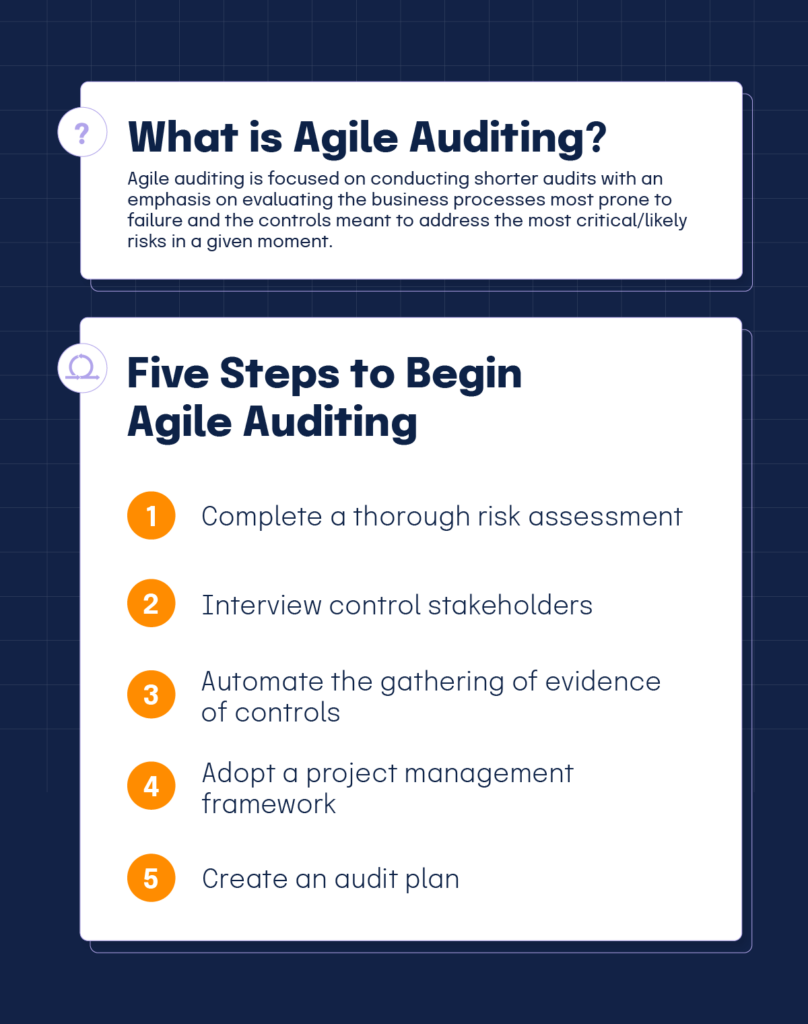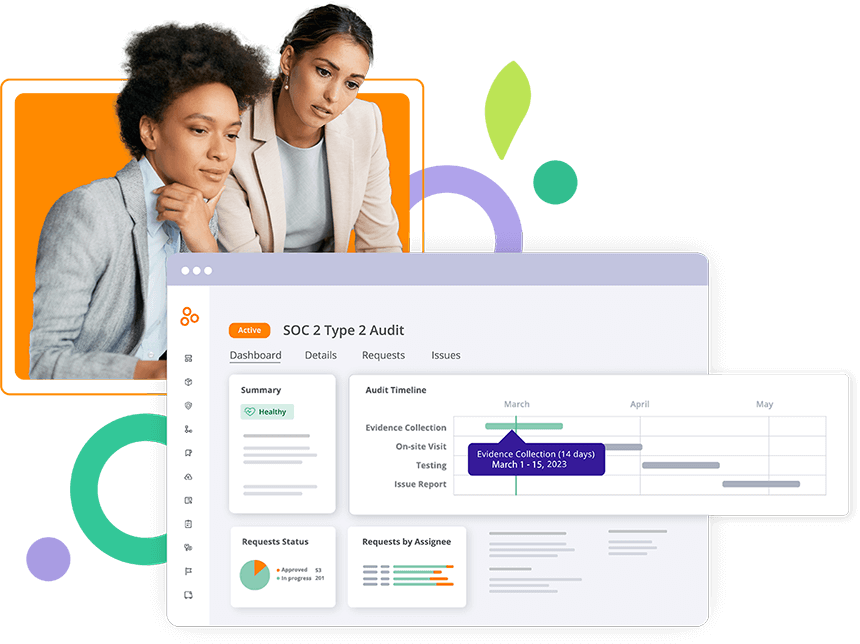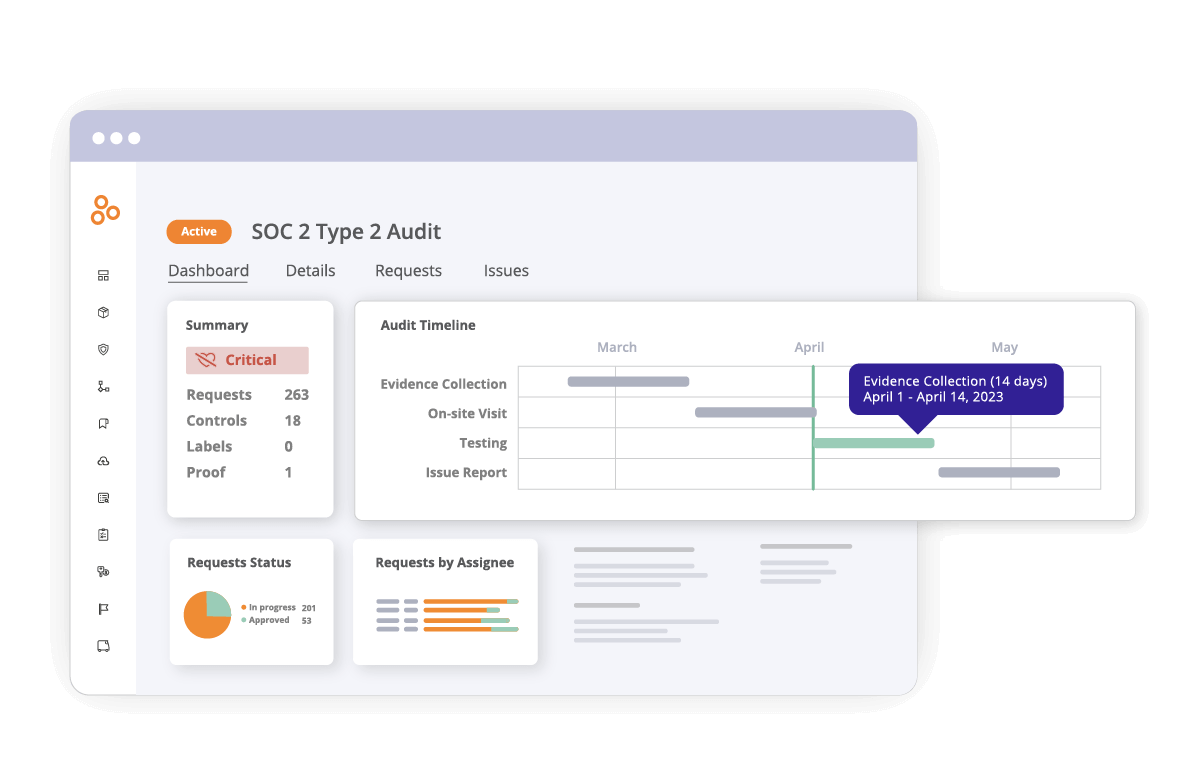What Is Agile Auditing? Essential Insights

For years, organizations have conducted compliance audits the same way:
- Create an audit plan
- Complete the audit plan
- Review the audit results
But, in recent years, this traditional method of auditing has proven to be too rigid and time-consuming, with little room for open communication between stakeholders.
The traditional approach to auditing has simply become inadequate. Compliance and security teams constantly adapt to changing requirements, while executives and customers increasingly seek assurance that their key assets are protected in today’s cyber risk landscape. Modern compliance and security teams need to have a real-time understanding of risks and control performance. Enter Agile auditing, a new approach to auditing that yields a higher level of assurance about the control processes under examination.
In this article, we explore Agile auditing and cover:
- Agile auditing definition
- Traditional auditing vs. Agile auditing
- Agile auditing benefits
- Simple steps for implementing it in your organization
- Measures of success.
The Agile audit methodology
Before looking at it through a compliance lens, it’s important to understand where the term “agile” originated. The agile audit methodology is not new in itself. In the early 2000s, the technology space was changing at a breakneck speed and many developers knew that the traditional “waterfall” approach to building and updating software wasn’t working.
The pace of software updates was infrequent, so opportunities for customer feedback were sparse. Without sufficient user data, it was difficult for developers to know if their product was meeting customer needs.
The Agile Manifesto was created by a group of developers in response. Though many of the principles were decades old, the Agile method was formalized and rose to popularity shortly after Y2K.
The four core values of Agile software development are:
- Individuals and interactions over processes and tools
- Working software over comprehensive documentation
- Customer collaboration over contract negotiation
- Responding to change by following a plan
The Agile audit methodology focuses on customer needs and relies on shorter work cycles, called “sprints”. Sprints allow for iterative, more adaptable software development. It also encourages open and frequent communication and collaboration between software developers.
What is Agile auditing?

Given the understanding of Agile’s roots, it’s not surprising that compliance and audit professionals have co-opted the Agile audit methodology to support their workflows.
It focuses on conducting shorter audits with an emphasis on evaluating the business processes most prone to failure and the controls meant to address the most critical/likely risks in a given moment. Instead of working through an inflexible list of steps, the process encourages internal audit and compliance teams to work iteratively on top priorities and attempts to call control owners to action as soon as issues arise. As with Agile software development, Agile auditing encourages communication and collaboration early and often.
Agile vs. traditional auditing
While this approach isn’t fully reinventing the wheel, there are some key differences between Agile and traditional auditing:
| Traditional Auditing | Agile Auditing |
| A rigid, long term plan is created and followed with little to no room for flexibility | While long-term goals are considered, plans are created in 2-3 week sprints and are flexible in how they are carried out |
| Steps are completed and then followed through to the end without reevaluating any prior steps | Because this model is focused on the highest risk controls and business processes in a given moment, steps are often revisited and reevaluated |
| Limited communication and collaboration between the auditor and the control/process owner | Stakeholders are encouraged to communicate and collaborate openly |
| Results are reviewed at the end of the entire auditing process | Results on control performance are shared as soon as tests have been completed |
Experiencing audit fatigue?
Learn how to reduce audit fatigue and compliance costs from security professionals ›

The benefits of Agile auditing
Changing to Agile auditing from a more traditional process can be a tough transition for some compliance professionals. However, there are notable benefits of Agile auditing to keep in mind, including:
Faster response time
This approach allows teams to respond quickly if an issue within a business process is detected or if a control needs to be adjusted.
Better understanding of organizational risks and controls
Because Agile auditing focuses on the highest-risk business processes and controls in an organization, it forces the entire company to fully analyze its risks and prioritize them. This leads to a greater organization-wide understanding of what requires the most attention and how accompanying controls are performing in real time (or close to it).
Increased confidence heading into external audits
With controls being closely monitored and updated regularly, internal teams have a clear view of their organization’s compliance posture before they need to meet with an external auditor.
Easily presentable findings for leadership
The Agile auditing process documents which organizational risks need to be addressed and what exactly is being done to mitigate them. With these comprehensive results readily available, compliance teams can easily deliver current key findings and status reports to their leadership teams.
Open communication and collaboration
A major piece of the Agile methodology is the belief that the audit/compliance team and business process/control owners should constantly communicate and collaborate. A successful Agile auditing process will help bolster healthy company-wide communication and collaboration that facilitates a culture of compliance.
Five steps to begin Agile auditing
If you’re interested in moving towards an agile audit model, here’s what to do:
1. Complete a thorough risk assessment
With an Agile audit, you want to be selective with the process(es) you audit. In order to feel confident about where to focus and how to structure your Agile auditing plan, you need to have a clear understanding of what risks your organization faces and the consequences of those risks. To do so, you should evaluate all current and potential risks and the controls (or lack thereof) tied to those risks.
2. Interview control stakeholders
Take time to speak to all control owners in order to understand how key risk areas are being addressed with controls. Further, ensure that the audit team and the control operators both know what evidence would clearly showcase that control processes are operating effectively. These conversations will also help you identify where compliance efforts overlap with other teams’ initiatives and how working on compliance-focused tasks impacts those teams.
3. Automate evidence collection for control operation
A way to speed up the process before the audit starts is to automate the gathering of evidence of controls whenever possible through technology. For instance, you can implement a compliance software tool that integrates with the operational systems you’re already using so that compliance-relevant reports generated in these systems can be automatically gathered into one place for easier audits. When the evidence collection process is automated, it eliminates unnecessary waiting periods and enables the audit team to run tests on controls sooner. Elevate your data security strategy! Explore the essential controls you should be auditing to protect critical data.
4. Adopt a project management framework and stick to it
Those who use the Agile methodology often utilize specific project management frameworks to track and organize their projects. Two popular Agile frameworks are Scrum and Kanban. Both frameworks are designed to help teams efficiently work cross-functionally and collaboratively.
5. Create an audit plan
Once you’ve conducted a risk assessment, interviewed control stakeholders, and automated controls where appropriate, you can develop a plan for completing your Agile audit. Your plan should outline each audit step in extreme detail and list the tasks that need to be completed consistently by control owners. Upon reading this plan, control owners should fully understand their responsibilities, properly manage their controls, and verify that control activities have been performed.
How to measure the success of an Agile audit
After you have created an Agile auditing plan, you’ll need to define how to measure success. These are some areas to focus on:
Reduction of time spent on audits
Agile workflows should create efficiencies throughout the audit process. As a result, Agile audits should take less time than traditional audits to complete. Streamlining the audit process will reduce tedious administrative tasks, giving stakeholders more time to work on other meaningful projects.
Improved response speed
Working in shorter cycles (sprints) consistently provides teams with up-to-date data. Organizations can use this data to make quick decisions regarding risk management. Monitoring the speed of responsiveness (e.g., making more frequent changes to controls within key domains) is a good gauge for whether an Agile auditing process is working.
More open communication and collaboration
Conducting an Agile audit will encourage stakeholders to communicate and collaborate openly, allowing for a smoother, less siloed workflow. Open communication also means that stakeholders will spend less time waiting for responses from other teams. This enables them to immediately take action on controls or processes that need to be fixed or adjusted.
How Hyperproof can support Agile auditing
Our compliance operations platform supports Agile auditing by giving compliance teams and business process owners a central source of truth for controls and risks. With Hyperproof, you can quickly hone in on critical controls and do the testing and accompanying remediation work all in one place.

Hyperproof is built with Agile principles in mind, allowing organizations to:
Monitor risk with a comprehensive dashboard right out of the box
Once risk or control owners complete mitigation activities, the risk health status is updated automatically in Hyperproof. This gives you real-time alerts on environmental changes.
Create audit plans, assign tasks to stakeholders, and track project completion
With clear project visibility and insights, you can easily track audit progress. Plus, stakeholders can see where they are in the process.
Easily select a set of controls you want to audit and automatically gather evidence of control activities
Hyperproof integrates with various cloud storage providers (Google Drive, Dropbox, Box, etc.) and operational systems (developer tools, application monitoring tools, CRMs, device management tools, etc.). It has native data connectors that automatically extract compliance info from source systems and pull it into Hyperproof.
Define cadences for control monitoring
In Hyperproof, you can define cadences and deadlines for reviewing controls with Tasks (which can be one-off or repeating). This way, you can rely on the system to auto-remind control owners to get their work done on time.
Communicate and collaborate openly
We built our compliance operations platform to meet people where they already work. Hyperproof integrates with dozens of services across cloud storage, project management, communications, cloud infrastructure, DevOps, security, and business applications so that compliance work can fit seamlessly into your existing business processes and workflows.
Ready to begin Agile auditing with Hyperproof? Request your demo now.
See Hyperproof in Action
Related Resources
Ready to see
Hyperproof in action?












